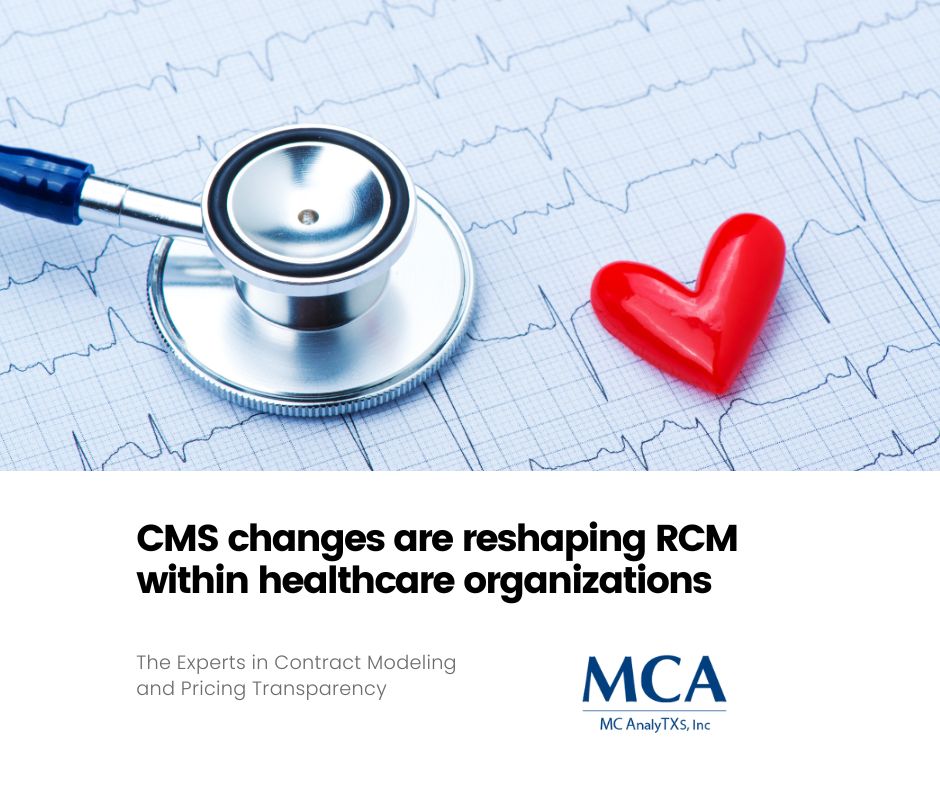

CMS changes are reshaping RCM within healthcare organizations.
The healthcare landscape is evolving rapidly, driven in part by new Centers for Medicare & Medicaid Services (CMS) transparency standards. These changes are reshaping how revenue cycle leaders within managed care organizations approach their operations. In this article, we’ll explore the impact of these new standards, and offer strategies for adaptation.
The Changing Landscape of Healthcare Revenue Cycles
The world of healthcare revenue cycles has always been complex, but recent CMS transparency standards have added a new layer of intricacy. These standards are designed to make healthcare costs more transparent to consumers, ensuring patients have access to critical pricing information before receiving care.
This shift towards transparency is significant. For many years, healthcare pricing has been shrouded in mystery, with patients often left in the dark about the costs they might incur. With the new CMS rules, hospitals and healthcare providers must publicly disclose standard charges for services, which is a major departure from previous practices.
For revenue cycle leaders, this change necessitates a reevaluation of existing processes. It’s not just about compliance; it’s about transforming operations to meet new expectations while still maintaining financial health.
Impacts on Managed Care and Revenue Cycle Management
The impact of these transparency standards is far-reaching, particularly for managed care and revenue cycle management. On one hand, they offer an opportunity for greater trust between patients and providers. On the other hand, they present challenges in terms of operational adjustments and potential financial repercussions.
Managed care organizations face the task of aligning their practices with these standards while managing the implications for contracted rates and payer negotiations. This can mean renegotiating existing agreements or developing new strategies to ensure alignment with transparent pricing.
Revenue cycle management teams must also consider how these standards affect billing processes and patient communication. The need to provide clear, accurate pricing information is paramount, and any discrepancies could lead not only to patient dissatisfaction but also to regulatory scrutiny.
Strategies for Adaptation and Staying Ahead
Adapting to these changes requires strategic foresight and a willingness to innovate. Revenue cycle leaders can take several steps to stay ahead of the curve.
First, maintaining open lines of communication with both consumers and payers is crucial. Transparency shouldn’t only be about adhering to regulations; it should be about fostering a culture of openness and honesty. Regular training for staff on these new transparency requirements can help ensure everyone is aligned.
Second, developing a robust pricing strategy that considers costs, competition, and consumer expectations will be vital. By taking a proactive approach, revenue cycle leaders can better anticipate changes in the market and adjust accordingly.
Lastly, investing in ongoing education and training will be key. The healthcare landscape is constantly evolving, and staying informed about the latest trends and technologies can provide a competitive edge.
Leveraging Technology and Data Analytics
Technology and data analytics play a critical role in optimizing revenue cycle performance under these new standards. With the right tools, organizations can enhance efficiency, ensure compliance, and deliver better patient experiences.
Advanced data analytics can provide insights into patient behaviors, allowing organizations to tailor their services and pricing strategies accordingly. Predictive analytics can forecast trends and help identify areas for improvement, enabling proactive decision-making.
Another technological asset is automation. Automating routine tasks like claims processing and billing can reduce errors and free up staff to focus on more complex issues, improving overall cycle efficiency.
The Importance of Proactive Adaptation
In the face of these changes, adopting a proactive mindset is essential. Revenue cycle leaders must not only comply with new regulations but also anticipate future shifts in the healthcare landscape.
Continuous improvement should be a core focus. Regularly reviewing processes, soliciting feedback, and making necessary adjustments will ensure organizations remain agile and responsive to change.
For those looking to explore further, numerous resources are available, from industry conferences and webinars to white papers and our expert consultations. Engaging with these resources can provide valuable insights and keep your organization at the forefront of the industry.
In conclusion, the new CMS transparency standards present both challenges and opportunities for revenue cycle leaders. By understanding their impacts, adopting strategic approaches, leveraging technology, and remaining proactive, organizations can not only stay compliant but thrive in this new landscape.
To learn more join our upcoming webinar November 21st at 1pm CST.





